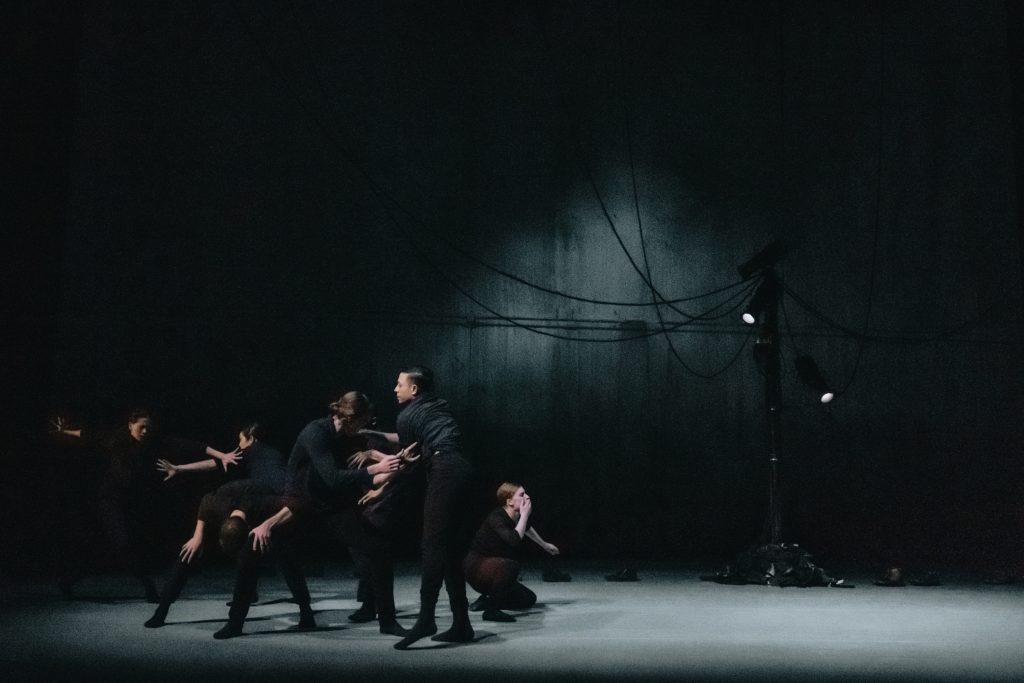Looking back at Olivier Wevers’ latest work for Whim W’Him

By Leslie Holleran
It’s convenient to view “Trail of Soles,” choreographer Olivier Wever’s latest work for his company, as a response to current events. After all, the work’s themes include migration, displacement and separation, and coincidentally it premiered during the longest government shutdown in American history, which occurred over funding desired by President Trump and the Republican Party for a border wall between the United States and Mexico. Yet, if viewed only through that lens, we could miss other, larger points about humanity that Wevers was trying to make, as well as its hopeful messages.
I chatted with Wevers earlier this week about “Trail of Soles” and his choreographic decisions, focusing on elements of the piece that hadn’t been discussed elsewhere previously, as well as the work’s broad themes.
The music by Gorecki – was it an aria? How did you find that?
Wevers: It’s the third movement of Gorecki’s Symphony No. 3, Symphony of Sorrowful Songs. It has a vocalist. The third movement is a song about a mother grieving for the child she lost. I’ve known this music for a long time.
Was there a symbolic meaning to the spotlights strung from the tall pole what were part of the set?
Wevers: There are a lot of meanings to that. Doing my research about refugees and refugee camps, all of the images I kept seeing were tents and poles and wires going through the tents. There’s a connection for electricity, for something, going through the camp. In the concentration camps [during WWII], they had lights on towers, so people couldn’t escape.
I also shaped the wires to look like a tree, a representation of the tree of life. How we are all connected. When you look at the shadows that are projected on the back wall and on the floor, you see a tree.
Poetically, metaphorically, I was playing with ideas that we are all connected, the tree of life, representation of refugee camps, representation of watch towers — all of those meanings.

You said you began to think about this piece six months ago well before the longest government shutdown in American history. What was it specifically about that moment in 2018 that compelled you to make the work?
Wevers: I had known I wanted to do something about refugees and immigration for awhile. The idea really solidified in June/July after “Silent Scream.” [“Silent Scream” premiered in June 2018.] I wanted to do something about immigration, refugees, displacement, and separation.
“Trail of Soles” is not just about what’s happening now. There’s a much broader picture. [Gorecki’s] music was inspired by WWII. My grandfather was in WWII, and he told me stories about escaping camps, jumping from the train when he was being deported, and being in the Resistance.
But, I was also thinking about how [these issues have been occurring] from the beginning of humanity, all of the big displacements… It’s not just about those that we know, but also those we don’t know. It happens all over the world, all of the time.
The piece left me with a hopeful message. Near the end, some of the dancers form a bridge with their arms, over the “border” made of shoes, through which other dancers were able to pass. Did you want to leave a hopeful message?
Wevers: I do, because what inspires me most is the resilience of humans. Seeing humans so desperate to get somewhere with their families that they will leave everything behind for a better life. There’s a survival, a resilience, that’s so fascinating to me. We all have it in us in some amount.
I wanted some hope in there, because usually walls get torn down or you find a way to get around the wall. You will always find a way to survive — to get to where you need to be, to get around the wall.
I have to believe in compassion and empathy. And, I have to believe that they are stronger than hate, than building things to keep people apart.
“Trail of Soles” premiered in January 2019 at the Cornish Playhouse in Seattle on Whim W’Him’s 3×3 program. Also on the program were “The Most Elusive Hold” by Yin Yue and “This Mountain” by Zoe Scofield.